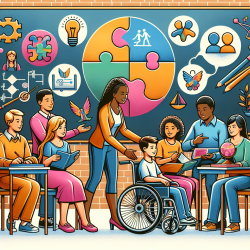As educators and support staff, our primary goal is to facilitate a learning environment that caters to the unique needs of every student, including those with physical and learning disabilities. The publication Teaching the Student with Spina Bifida offers comprehensive insights into the challenges and strategies involved in educating students with this condition. Spina bifida, a neural tube defect that affects the spine, presents a variety of challenges in the educational setting, ranging from physical disabilities to learning difficulties. By implementing the outcomes of the research presented and encouraging further research, practitioners can significantly improve their skills and the educational experiences of these students.
The book is divided into several sections, each targeting different aspects of educational support for students with spina bifida. The first section emphasizes the importance of health and related services in educational settings, highlighting the need for a cooperative, multidisciplinary effort. This approach ensures that students receive comprehensive support that goes beyond academic learning, addressing their physical, emotional, and social development needs.
One of the key takeaways from this publication is the emphasis on tailoring the academic program to meet the unique needs of students with spina bifida. The book provides practical information for professionals who teach or consult directly with these students, discussing comprehensive psychological assessments in the context of the student's unique medical history and disabilities. It covers a wide range of cognitive and learning profiles, offering strategies for assessing and teaching abstract concepts, mathematical skills, and addressing attention, perceptual, and language deficits.
- Understanding and Supporting Learning Differences: The publication stresses the importance of recognizing the wide variety of cognitive and learning profiles among students with spina bifida. Educators are encouraged to adapt their teaching strategies to address these differences effectively.
- Practical Strategies for Teaching: For subjects like mathematics, the book offers insightful strategies for evaluating and remediating skills, emphasizing the need for functional learning. Additionally, it provides guidance on managing attention, perceptual, and language deficits, which are common among students with spina bifida.
- Focus on Independence and Social Skills: Beyond academic achievements, the book also discusses the development of independence and social skills. It covers strategies to deal with behaviors that interfere with functioning as an independent individual and offers suggestions on creating effective parent-teacher partnerships.
Another critical aspect covered is the transition to adulthood. The publication suggests that the vocational, social, and economic outlook for students with spina bifida can be challenging. It emphasizes the importance of early preparation for this transition, focusing on developing necessary personality traits, work habits, and interpersonal communication skills.
Furthermore, the book highlights the legal rights of students with spina bifida, including the right to an Individual Education Plan (IEP) in the United States. It discusses educational services available in the American school system, underscoring the need for tailored educational plans that meet the specific needs of these students.
In conclusion, Teaching the Student with Spina Bifida serves as an invaluable resource for educators, providing a thorough understanding of the multifaceted needs of students with spina bifida. By adopting a multidisciplinary approach and focusing on tailored educational strategies, practitioners can significantly enhance the learning experience and overall development of these students. The book's insights into practical strategies, transition planning, and legal rights are particularly beneficial for educators seeking to improve their support for students with spina bifida.
To further explore these insights and strategies, Teaching the Student with Spina Bifida is an essential read for any educator or support staff dedicated to making a difference in the lives of students with special needs.










